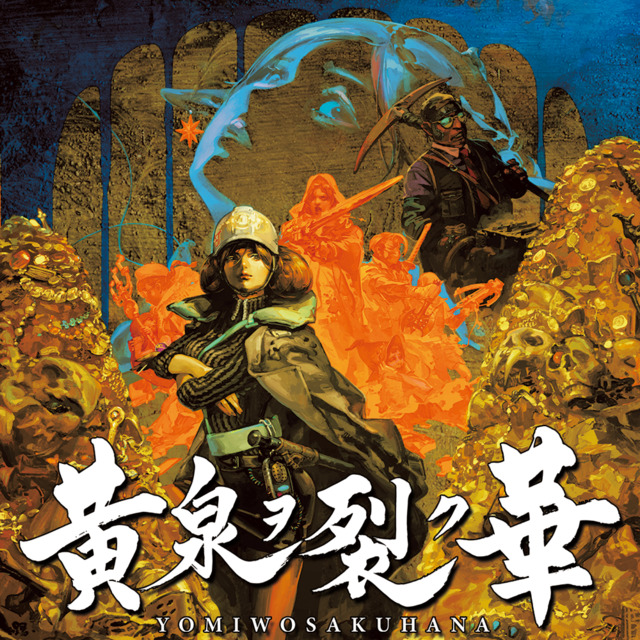Undernauts: Labyrinth of Yomi
Undernauts: Labyrinth of Yomi
Developer: Experience, Poppy Works
Publisher: Aksys Games.
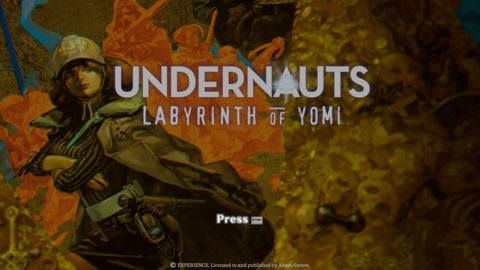
Those which read my previous blog post about the Wizardry successors, might remember In the end I said “Also I want to check out Undernauts: Labyrinth of Yomi, which I released in Steam a while ago, but I haven’t able to see it.”. So that time come a bit later and now after finish it, I can say it one of the best dungeon crawlers of the Wizardry lineage, so what is all about…
Undernauts features a rather unique setting for its dungeon crawl, it is late 70s and early 80s Japan, where one of Tokyo districts vanished and in its place a mysterious alien like structure later called Yomi appeared, bring with it a new form of energy, Argen, that attracted lots of people to the city. However, mining it was so dangerous, that despite an initial boom, now the business have declined, but there is still the demand of the new energy and people desperate enough to not only go inside, but join shady mining firms, even inject Argen inside their bodies to be able to fight the dangers there, giving birth to the Undernauts.

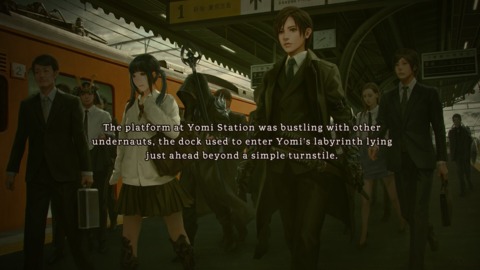
Your main character is a chief deputy of a mining division of Cassandra co, which work under the Yomi Corporation, the story start with your main character going with a party in what appear to be standard expedition on the mines, but things go absolute wrong as you cross ways with a mysterious girl which kill your entire party and left you to die there. Your character manage to escape to the main camp, where you can build a proper party and start to figure what is going on…
While more modern settings isn’t unusual for Experience games, given the Spirit Hunter series and even some of their older dungeon crawlers, in Undernauts, late 70 and early 80 Japan is both show in small lore pieces you will uncover, from item and monsters descriptions, which attempts to tie the more historical aspect and the fantastical ones, and the art, specially the character illustrations, which use a combination of somewhat period clothing and pieces of armor. Then there is the music, which mostly use Saxophones, and it is amazing.
Overall, Undernatus is a slightly more horror toned dungeon crawl with bits of fantasy and sci-fi in the mix, elements which Experience have used a plenty in their previous games. But the main tone, while not in fully explored, is more about your character being workers in a desperate situation, but full of ambition, at whims of others, specially powerful corporations, but also trying to figure what is going on around them.
Dungeon Crawling and Flowers
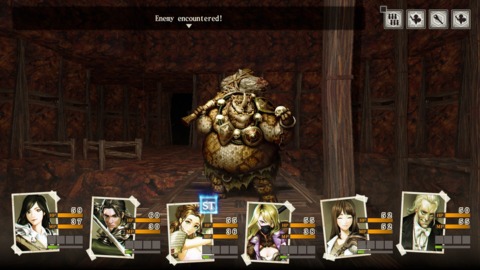
Undernauts dungeons are overall very similar to previous Experience games, they are 30x30 in size, feature different textures and design for each map, each dungeon can feature different floors or connected maps.
Kind like in many of the Wizardry successors, you have a main base, from which you can explore dungeons, however, they are sort connected, meaning that from the main base, the Camp 1, in certain way you can branch to three other dungeons, from these dungeons you can go to other linked dungeons.
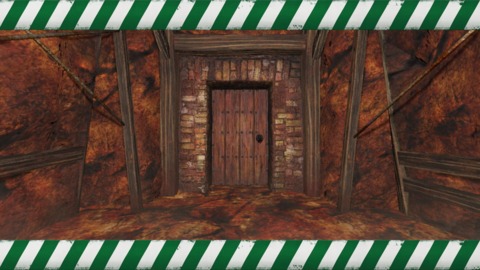
Now the major new features are the Flowers, a unique resource which you can create in a Fusion Reactor by spending Flower Points which can be extracted from items. Each type of Flower can modify the map in certain spots, Bridge Flower can close a chasm, Door Flowers allow you to create secret passages in walls which allow it, Healing Flowers allow you to either heal or neutralize hazards (such as spike floors), and so on, you can even create the Monster Flower, which create a fixed encounter for easier grinding (and it comes in three variations, each one, adding a new wave of enemies to the encounter). And that is not all, you can even use a Deletion Flower to remove a fixed encounter in the map, while later on gain access to the Great Door Flower, which allow for fast travel between maps.
In case you feel you no longer need something which you made, you can easily go to the Reactor and delete used Flowers, gaining back some Flower points.
Now you won’t have access to all of them in the very start, instead as you progress in the plot you gradually gain access to them, which encourage you to revisit old maps to explore them.
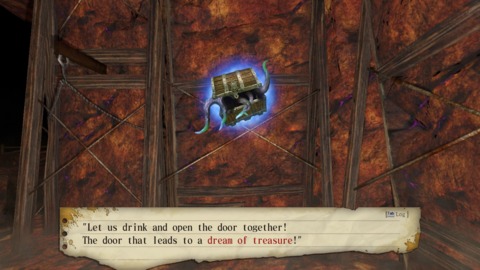
There are another two additions, one is the Purple Flowers, which feature a fixed encounter that until you defeat, the chances of ambushes are way higher. Another curious addition, is the Dream Treasure maps, along the way you will find mimics NPCs, which ask you for wine, give it to them and gain access to unique maps which feature lots of loot, but require many Flowers to properly explore them.
Moving from this, overall map design feel great, never too large but right on size, some maps can feel a bit more annoying to move, but I would limit this to one which features a lot of pits (later on you got something which protect you from pitfalls). There are only a handful of puzzles, mostly are fine and concentrated in the early dungeons, and involve often figure some input code or navigation puzzles. Now on the encounters, maps feature mostly fixed marked encounter, but as I said above, ambushes can happen, specially before you defeat the local floor Purple Flower(s).
Again, spacing between and rate of encounters overall feels fine, and even when you need or wish to grind it is easy with the Monster Flowers, so you don’t even need to wander around.
One final note, some classes, like Ninja and Hunter, feature skills which affect the encounter rate, one increase chances and the level of monsters, while the other do the opposite.
Making a Party

Like most Experience games, Undernauts does feature their standard set of classes, with some slightly name changes, to reflect the more modern setting, instead of Knight you have Bulwark, Samurai are Fencers, there is one sort addition, the Tactician, which I sort a two-handed based warrior, despite the name suggesting something else…
In total, you got eight classes, Tactician, Bulwark, Fighter, Fencer, Hunter, Ninja, Cleric, Sorcerer, your party will be formed by a main character, each you create at the game start, after that you can add up to five character to the party (kind like in their previous games, specially Stranger of Sword City).
When creating a character, you first choose a initial profile, which is mostly a suggestion, even featuring a potential background which you can edit later. Also, here, you find some profiles which are from other Experience games. After that you can choose both a background and trinket, each one give some initial bonus to some stats.
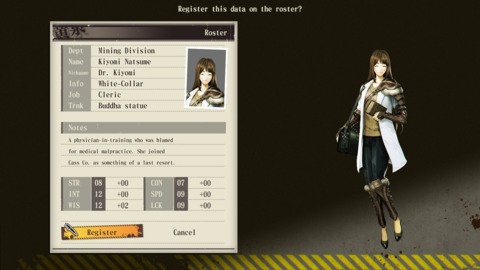
By last you can choose your character Appearance, here is another small feature, because each illustration does feature some variations, like different colors or details. Again here, characters art from previous games appear, even ones which are some initial concepts for Undernauts.
But unlike their previous games, class structure is a bit more rigid, specially compared to Stranger of Sword City, here you choose class and later you once you got a special Promotion Argen, you can either become specialized version, gaining access to advanced skills of the said class or sort become multiclass by adding a second one, by gaining access to a second class basic skills.
As you gain levels you gain skills points, which you use to buy skills and improve them, the skill selection is a bit limited, but it works, also you can respect at any time. Unlikely to previous games, there are no resurrection skills, for plot reasons, which cause a bit of problem, as you are often forced to either have a rare item in hand which can save a character when killed or return to the base camp.
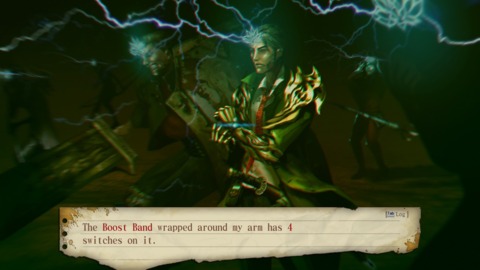
Sort like in Stranger of Sword City and other games they made, Undernauts also features a selection of special abilities which you can use at the start of each turn. Here they are called Boost Swap, and the concept is similar, but more limited, the idea is that your main character can use a special gear that allow the Argen inside the party to react in a certain way. You have three abilities: Overcharge, which during a single turn reduced the MP cost of skills to zero and also increase how effective they are, Duracharge which both reduce damage by 50% and raises resistance, plus some free healing, and Neurocharge which make sure your party will act first in the round, while also, if you finish the combat using this, give you extra XP and treasures. Once one is used, it takes some time to recharge, so you need to be cautious to proper use it, but unlikely Stranger of Sword City, there is no key ability, like the one which protected from Charm, so you are more free of how to use it.
Combat
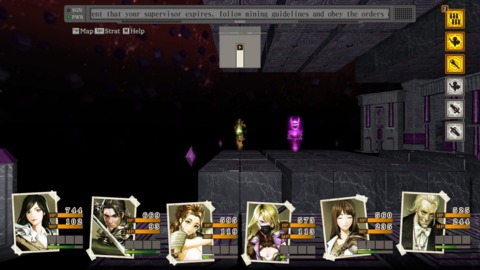
Undernauts battles feel similar to previous games, the overall structure is similar, you face up to three enemies in up to three ranks deep. However, since some skills work different or don’t exist, the pace feels different, as I said above, there is no resurrection spell, instead you need the Substitute Ball Ex, which does not bring back a character, instead, it protects it character from dying, being used once triggered. This mean you don’t have a more reliable method to recover if stuck hard during combat, making down spirals more likely. Because this is a very rare and costly item, you can’t really on it.
On the other skills, you still have a plenty which perform line attacks, specially for the Tactician and Samurai (but his skills come in expanse of defense, making it out to risk using it), both Hunter and Tactician feature concentraiton skills, which have to be used to allow some late skills to work. Bulwark got many of the party wide protection skills (however, I never used this class).
Now on the magic field, buffs pre-battle have been reduced to Enduring Adroitness (a cleric spell, which give some stat boosts) and Magic Permabarrier (which protect from magic effect and instakills), outside this two you sort have Hunter’s, Signal Whistle, which give some minor stat boost and protect your party from formation breaks.
The other spells go mostly standard, however sometimes spells descriptions are a bit unclear, since some spells start affecting only one target, but upon spend skills points they do change, depending on the spell, to either affect the whole party or all enemies (at least in line), something I only figured out much later, but other not.
This isn’t helped by sometimes you have both version of the same spell, as Medi (single target) and Mult-medi (whole party), which might trick you in to think that other spells maybe follow the same format, but no. Other times you have Androitness (single target) and the Enduring Androitness (whole party), but also that Androiness spell also become a party wide… In the Sorcerer’s skills, you have a skill for each element (which in turn to hit all enemies in higher levels) but also a single dark based skill, Dark Catasphore, which hit all enemies and Pentakinesis, which hit a single enemy with all elements.
However, since you can respect at any moment, you can experiment and change in easier way.
The combat, between monster variations and design and your party skills feels great, outside the inability to properly resurrect party members, pace and rhythm feel fine and there is no sense of cheap shots or things happen out of nowhere, save from some very optional post game content, and some bosses which help during combat between some turns.
Risk and Reward

Gear in the game is mostly got by fighting enemies and finding some random treasure around the maps, but outside the already mentioned Treasure Dream, you can also create anything you already find in the fusion reactor (I think as long you also have either converted a previous version to Argen or in Flower Points) along to buying items.
The fusion reactor is also where you improve your items too, which can go up to 99, but the increments amounts are limited by the plot, as depend on the Fusion Reactor being upgraded.
The game does feature a good variety of items without falling in the standard excessive loot problem, each item, which might feature different plus and stat boosts, making rewards feel like rewards, classes are flexible enough to allow you to use almost all stuff you find (specially with the ability to respect), so you are more encouraged to use new stuff. Meaning, you are encouraged also to take riskier battles. Also one little helping feature, is that when you find loot, the games does point if the item is new and if is of a higher upgrade of already you have.
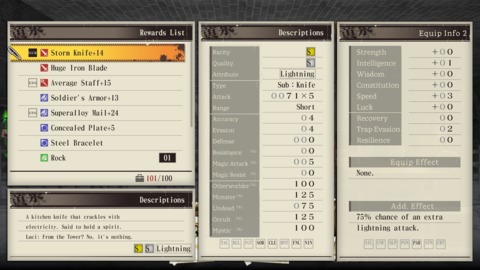
The curve of difficult feels fine too, like I said in a previous piece, the start can feel a bit harsher, but things smooth out, leading to a soft pace, with some eventual spikes, but nothing harsher, after you finish the main story, there is some post game content, which is way harder, but nothing beyond normal you would expect for a post-game content in a dungeon crawler (most difficult might be some of the late bosses, but that is it).
Conclusion
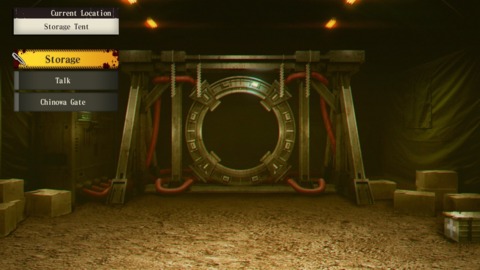
Experience is a small developer with limited resources, but still, their dungeon crawlers, specially of the Wizardry linage, feel among the best, Undernauts also feel like their most well-developed game, both in visual and in mechanical terms. The setting maybe could be explored more, as sometimes some small pieces of lore feel like people simple slap the word Yomi in to everything, but there is some good or intriguing pieces, between the plot and some characters backgrounds. While there are some minor dialogues choices, most appear to have no effect, something that could be slightly better.
But the overall story feel intriguing, along with the game pace and rhythm feel very smooth experience. So, yeah I would really recommend this game, which is my GOTY maybe in first place.
